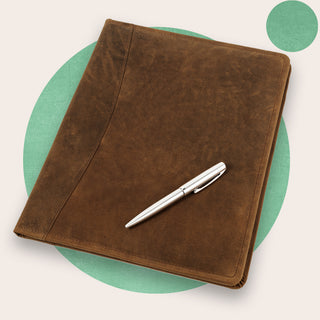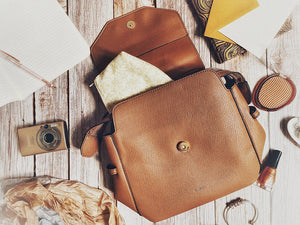Telling the difference between real and faux leather can be challenging, especially when you don’t know what to look for. In the next few sections, we’ll lay out five different steps that you can take to help you learn how to tell if leather is real. Continue reading so you can apply these steps the next time you’re shopping for a new leather jacket, leather handbag, leather journal, leather duffle bag, or any other leather products.
Different Types of Leather
Before we get into how to distinguish real leather from fake leather, it is important to take a few minutes to learn more about each of the different types of leather—both real and fake—that you may come across.
Real Leather
First up: real leather. Real leather, which may be either top grain leather or full grain leather, is the real deal and what you’re looking for when you’re searching for an authentic piece. For those wondering what is leather made of, real leather is made from animal hides. Cow hides are most commonly used, but real leather can be made from any animal hide, including buffalo, deer, crocodile, and ostrich.

Genuine Leather
What is genuine leather? The term genuine leather can be misleading. While it sounds like genuine leather and real leather are the same thing, they are actually not. Products labeled as genuine leather are typically the lowest grade of leather. They are often made using scraps of leather, as is the case with bonded leather, and may only include a small percentage of real leather.
Faux Leather
Faux leather is fake leather. It is made using synthetic materials that are designed to mimic the look and feel of leather.
Many faux leather manufacturers, however, use some misleading terms to label their goods. Rather than outright stating that the item is fake or faux leather, you may see some of these other terms used.
- Vegan leather
- PU leather
- Pleather
- Leatherette
- Synthetic leather
- Piñatex leather
- Ocean leather
How to Tell if Something is Real Leather
Use the steps outlined below to help you identify whether a given product is indeed made from real leather.
1. Check the Label
One of the fastest and easiest ways for how to tell if leather is real or fake is to check the label. Authentic leather should be marked as such. Faux leather products should also be labeled with the materials used. If you see anything labeled as bonded leather, PU leather, vegan leather, synthetic leather or with any of the other terms shared above, it is not real. Remember, genuine leather is often used to make something sound like it is real leather, when in reality the item contains a lower grade of leather along with other binders and materials.
2. Examine the Appearance
Another way to tell the difference and decide whether something is real or fake is to check the appearance. If you look closely at, for example, a leather pencil case, you can often spot fake leather or a machine made piece. Real grain leather has natural imperfections, rough edges, and a unique texture. Fake leather, on the other hand, typically has a more consistent pattern, perfect edges, and a more uniform texture.

3. Feel the Material
Feeling the material can also be a good indicator as to whether you’re looking at authentic leather or something made from synthetic materials. Real leather will feel coarse. When you press down on it with your hand, it should wrinkle and move, much like your own skin could. Fake leather will have a different texture and won’t stretch or pass the wrinkle test as you press on it.
4. Smell the Material
Real leather has a distinct aroma, so performing a smell test can also be helpful when you’re trying to tell the difference. To determine if leather is real, pay attention to the smell. Because real leather is made from animal hide, it should have a noticeable aroma that smells very natural. Fake leather smells quite different—either odorless, like chemicals, or plasticy.

5. Other Things You Can Check
Below are a few other things you can check to tell the difference between real and artificial leather:
Price: The price tag can also help you assess whether an item is made from real leather. Real leather is more expensive because of its superior quality and the level of craftsmanship that is required to produce it.
Water test: Performing a water test may also help. Real leather (that hasn’t been waterproofed) will absorb a few drops of water. Fake leather, on the other hand, will repel it.
Check the back of leather: If possible, look at the back of the leather. If it is fake leather, the back may look like paper or fabric. The back of authentic leather will often different slightly in color from the finished side. It may also be smooth or rough, but it will not look like paper or a completely different type of material.

Wrap Up: Real Leather vs Fake Leather
After reading the steps shared above, do you feel that you can now tell the difference between real leather and faux leather? Identifying leather and determining whether it is real or not is definitely doable. Give yourself some time to practice and hone your skills, and you should be a pro at distinguishing between real and fake leather in no time.
FAQs
What is the difference between genuine and real leather?
Real leather is 100% authentic leather made from animal hides, such as full grain leather or top grain leather. Genuine leather is a lower grade, which often includes only a small percentage of authentic leather.
How can you tell the quality of leather?
Full grain and top grain leather are considered the highest grades of leather. You can identify these grades of leather by examining the look, feel, and smell of the leather, as explained above.
What is considered fake leather?
Faux leather products are not made using animal hides. They are often made using a man made material, including different types of plastic.
Can you scratch real leather?
Yes, you can scratch real leather. However, it won’t scratch as easily as bonded leather or faux leather, in most cases.



